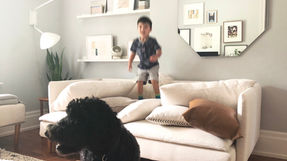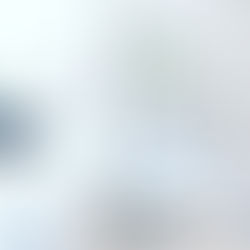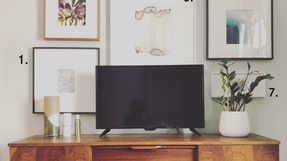...And Kids' Art Display Wall

This post contains affiliate links. See disclosure.
This week's post is our latest DIY project: a command center and kids' art display wall!
While researching last week's post on creative ways to display kids' art in the home, I saw Young House Love's DIY cork wall project and immediately thought I need one of those in my life! And, I had just the spot for it!

This neglected back corner of our kitchen, facing the mudroom, has been begging for a purpose.
When designing our kitchen, we thought we'd eventually put a tall, narrow, built-in cabinet here. However, we've found that we have more than enough kitchen storage to suit our needs, and the spot has remained empty and unloved---until now!
What makes this the perfect spot for a command center/kids' art display wall, you ask? It’s hidden away! You can't see it at all from the living room. So, it won't add visual clutter to the rest of our home.
If you've been following along for a while, you'll know that I tend towards a minimalist aesthetic and detest clutter! I take pride in the fact that our living room looks like we don't have kids and our kitchen counters are practically bare!
In addition to the Young House Love-style cork wall, I thought a chalk board would also work well in this space.
The cork board provides an area to post bills (and other papers) requiring action, as well as my son's art; the chalk board can be used to jot down quick notes/to-dos and provide a creative outlet for my son in his favorite medium!
This is how we created a DIY command center and kids' art display wall in our kitchen using chalk board paint and cork tiles.
Part 1: The Chalk Board Wall
Materials
Chalk board paint (we used Rust-Oleum)

Instructions
1. Outline the area to be painted. I started by applying a perimeter of painter's tape to protect the surrounding wall and the moulding below. I've never been good at coloring within the lines!

2. Paint the wall. True story: when I first cracked open the paint tin, I immediately thought I'd picked up the wrong color. I had to double check that the box indeed said 'black.' But, even then, I thought maybe the can was packaged in the wrong box. I brought this theory to my husband, Eric, who had a good laugh and told me to mix the paint before coming to that conclusion.

Sure enough, the black component was sticking like tar to the bottom of the tin. Not-so-pro tip: chalkboard paint requires a more thorough mixing than regular house paint!

Having solved that mystery, I applied the first coat.

I used the foam roller for most of the job, and the small brush to fill in the gaps at the edges.

3. Apply a second (and third) coat. After allowing the paint to dry for the prescribed three hours, I applied a second coat, and later, a third coat (for durability's sake).
PSA to my fellow MDs: those scrubs you *forgot* to return while on your OB rotation make for great painting attire!

Chalk board complete!

I know! It looks uneven. Don't worry about perfection at this stage. I made sure to paint above where I'd planned for the cork wall to start, so any imperfections at the top border would be hidden. I promise I used a level for that next step!
Part 2: The Cork Board Wall
Materials
Cork tiles 12" x 12"



Exacto knife
Scissors
Measuring tape
Level
Pen (I didn't think to include it in the photo...you know what a pen looks like, right? Perhaps DIYs aren't my forte).

Instructions
1. Create a foam board backing for the cork wall. Using the pen and level, I traced out the desired footprint of the cork wall, above the painted area (but overlapping its top edge). I measured the dimensions, then used two pieces of foam board (one solid piece and three cut-out pieces) to construct a Tetris-style backing for the cork wall that would fit exactly within the space.

Alternatively, you can use a thin piece of wood underlayment as the backing, like they did in the Young House Love project. (I, personally, didn't want to break out the table saw)! It doesn't really matter what this backing looks like, since you won't see this part when it's done. It just provides a push pin buffer between the cork board and your walls.
2. Apply adhesive to the foam board pieces. I attempted to apply the construction adhesive to one side of each piece of foam board. This required more grip strength than I possess (to its credit, the adhesive seems to cling even to the inside of the tube and it's very dense----like drywall putty). So, I got Eric to do this part for me! If you've read my DIY chair reupholstery post, you may recognize a pattern here...

3. Apply the buttered foam board pieces to the wall.

4. Apply double-sided adhesive stickers to one side of the cork tiles (these come with the tiles).

5. Stick the cork tiles onto the foam board backing. We needed 2 and 2/3 of a tile for each row.

After applying two tiles across, I measured the size of the gap between the two tiles and the wall, and cut the third tile to size.

It was tricky cutting the cork tiles without little bits crumbling off here and there. I wasted a few tiles in the process. Make sure you get more tiles than you need for the project. You can always keep the extras as replacements for worn out tiles.


6. We repeated steps 4 and 5 for each of the three rows.

I decided to make the cork wall exactly three tiles high to avoid having to cut the top set of tiles to height. Where there's an easy way out, I'll take it!

Part 3: The Storage Ledge
We added a small shelf for the requisite chalk, pens and tacks. It will also make for a temporary resting place for unopened mail.
Materials
-
Though, any wall storage unit will do!

Wallniture Wall Shelves - Set of 2 ($23.99). These black ones save you the spray painting step.
Spray paint primer (optional)

An electric drill & screws
Instructions
1. Spray paint the shelf. We sprayed the IKEA shelf with primer (optional) and allowed it to dry for an hour. We then repeated this step using the matte black spray paint x 3 coats. If you notice me changing pronouns from 'I' to 'we,' that usually means Eric is involved!


2. Drill the shelf into the wall. We used the electric drill to hang the shelf just below the cork tiles.

Ta-da! Our DIY command center!

I love the way it turned out! I'm really digging the matte black finish of the chalk board paint. We still have a lot left, so I'm toying with the idea of painting our tiny powder room (or one of its walls) with the remainder. It's a 'no' from Eric right now, but that's never stopped me before...
Part 4: Accessorize & Decorate
(this is my favorite part!)
Materials
A wall calendar & pen
Kids' art. Start with your kids' favorites; you can cycle in new pieces regularly---like a rotating exhibit!

Owen's daycare creations.
Instructions
1. Apply the organizational items to your command center.

Our command center contains a calendar, chalk, a pen, tacks, and a binder clip for bills and other paper items requiring action. We're using tacks as makeshift key holders, for now.
2. Fill the rest of the space with your kids' best work!




There you have it! Our DIY command center/kids' art display wall!
Customize It
Each family is unique. Your family's command center needs likely differ from ours. You may want a more extensive area for papers, an inbox/outbox folder, a dedicated key rack, or a white board. We may need to add some of these things once Owen starts kindergarten, and the influx of permission forms and newsletters begins.
mDesign Hanging Fabric File Folders ($11.99).
Design Styles Wall Double File Holder ($24.99).

mDesign Letter Holder Key Rack ($12.99).
Not into the whole DIY thing? This is a compact, versatile, ready-to-go solution:

Do you have a home command center? Where do you display your kids' art? Let me know in the comments below!
If you want to be notified each time there's a new post, please subscribe!
You May Also Be Interested In:
If you enjoyed this post or know someone who might, please like/share/pin/tweet using the icons directly below!

































This ref. 1463's condition speaks for itself. It still has its original presentation strap, original red box with gilt Calatrava logo, and it has never been cleaned or polished. As an example of a ref. 1463, it is a link holy-grail specimen. link Its remarkable history brings it to a new level. The engraving on the caseback: "Carroll Shelby. Aston Martin. 1st LeMans link 1959. 2701 Miles" is perfectly preserved.
akun5000, slot qris, slot dana, akun5000, slot deposit dana, slot gacor, slot gacor, akun5000, slot qris, slot qris tanpa potongan,
akun5000, toto slot, slot dana tanpa potongan, akun5000, akun5000, slot deposit qris, slot deposit dana, slot gacor, slot gacor, akun5000,
Click here provide members with discounts on over-the-counter medications, vitamins, and health essentials, promoting better health management and cost-effective wellness solutions. kaiserotcbenefits.com - more details here
Click here help you find recent death notices, providing information about funeral services, memorials, and tributes for loved ones in your area. obituariesnearme.com - more details here
Click here? Many users have had mixed experiences with the platform, so it's important to read reviews and verify deals before booking. istravelurolegit.com - more details here
slot gacor resmi, agen slot gacor, link daftar slot, slot online, slot gacor online, slot gacor resmi, daftar slot, slot via qris, slot gacor terbesar, slot, daftar situs terpercaya, akun maxwin, agen slot gacor, judi slot, judi slot, slot online, situs slot gacor, link daftar slot, raja slot gacor, slot online, judi slot, daftar slot gacor, judi slot, slot online, link slot, daftar judi slot, situs slot, slot, slot online, slot gacor terpercaya, agen togel, toto togel, slot88 resmi, judi slot, slot gacor resmi, slot online, slot thailand resmi, link slot thailand, daftar situs slot, agen togel resmi, slot gacor, link slot gacor, slot gacor resmi, slot terpercaya, slot gacor terpercaya, pasaran togel, daftar slot, situs slot, link slot gacor,…